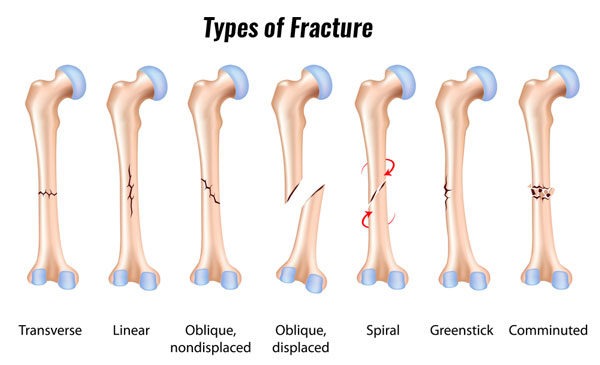What is a fracture?
A broken or cracked bone is referred to as a fracture. You can have a partial fracture or the bone may be completely broken or dislocated. Luckily, bone is able to repair itself. Some fractures need to be managed conservatively with a cast, sling, or boot to immobilise the area and to protect the injured site so that it heals in the precise position. At other times, surgery is required to correct the position of the bone so that it can heal in alignment.
The human body has over 200 bones that uphold and shelter the soft tissues and movement. Healthy bones are strong and take a huge battering from us on a daily basis. They are slightly bendy so can bear a certain amount of force without breaking. Putting a lot of force onto a bone, for example during an accident or fall, will cause the bone to fracture. Additionally, if you suffer from osteoporosis, the bone is already brittle and can fracture with minimal force.
How are fractures categorised?
A fracture can also be displaced or undisplaced:
- In a displaced fracture, the fragments of bone have moved out of line. This can make the area (for example, your arm or leg) look misshapen
- With an undisplaced fracture, the broken parts of the bone have not moved out of position
Fractures can also be known and described by the type of fracture line they form across or along the bone, as highlighted below:

What are the early signs and symptoms of a fracture?
The most common symptom of a fractured bone caused by a single accident or injury is immediate pain. This can be severe and may stop you from moving the injured area.
The other symptoms you may have include:
- Swelling
- Bruising
- The area looking deformed or out of place
What causes a fracture?
The most typical causes for fracturing a bone are:
- An accident or injury that puts severe force on your bones, for example a motor vehicle crash or sporting injury
- Having an underlying health condition such as osteoporosis that weakens your bones
- Using repeated weight on a singular bone
How is a fracture diagnosed?
Your doctor will ask you about your symptoms and examine you for signs of a fracture. They will also take your medical history and ask about how you injured yourself. You will usually be sent for an X-ray to confirm whether or not you have a fracture. With fractures, most cases are extremely painful. Moving the injured site or putting weight on/through it may be extremely painful. This often indicates the severity of an injury prior to imaging.
How is a fracture treated?
Your doctor will use one of the following techniques to hold your bone in place while it heals, known as immobilisation. They will give you guidance as to what you should and should not be doing during the first six to 12 weeks following your injury. This information or protocol is important to pass on to your physiotherapist.
Immobilisation
Your doctor may ask you to wear:
- A cast
- A splint
- A brace
- A sling
Surgery
If your fractured bone will not heal with immobilisation alone and surgery may be necessary fix the fracture first before it is immobilised. The repair will almost always need to be fixed with metal screws, pins, rods or plates to give your bone the best chance of a full recovery. There are two types of possible surgeries:
- External fixation: a surgical treatment used to set bone fractures. Rods are screwed into bone but the metal work is visible outside the body.
- An internal fixation: surgery using implants made of stainless steel or titanium, screws, rods, or plates. The components used to provide stability are positioned entirely within the body.
How can physiotherapy help you with your fracture
If the injury is in your leg, you may be asked not to weight bear or only partially weight bear. You may be given elbow crutches or a zimmer frame to assist you. Physiotherapists can guide you at this point forward. They can show you:
- How to go up and down the stairs safely with crutches
- How to walk correctly with them
- How to strengthen your affected limb without damaging it further
- How to reduce the swelling in the affected limb
- How to wean you off your walking aids and to progress you back to normal mobility and function
How physiotherapy can help you after your fracture has healed
Physiotherapy is often required after a fracture has healed due to residual weakness and stiffness in the joint. We will do whatever we can to get you on the fastest route to recovery. Some of the treatment methods we use include:
- Mobilisation
- Strengthening exercises
- Myofascial trigger point release
- Pilates
- Cross-friction massage
- Stretching and range of movement exercises
- Acupuncture
- Functional exercises
- Kinesio-taping
